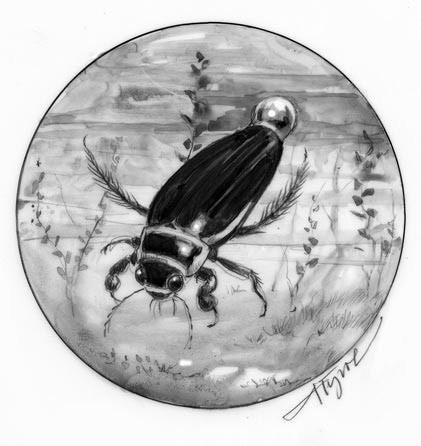
Every morning, my pool is the scene of six-legged tragedies: chunky beetles puttering around on the surface, looking for a leaf-cum-life preserver; a few flies long since deceased. Once, the surface was peppered with black commas. These turned out to be winged ants, unlucky breeders from a nearby colony that must have swarmed. Each morning the suite of insects is different, but the result is almost always mass death.
To creatures so large as ourselves, a pool’s surface tension offers only token resistance. Insects, however, find themselves in a very awkward place. Lest one forget the importance of scale in the animal kingdom, take this bit from biologist J.B.S. Haldane’s essay On Being the Right Size: “You can drop a mouse down a thousand-yard mine shaft; and, on arriving at the bottom, it gets a slight shock and walks away. A rat is killed, a man is broken, a horse splashes.” An insect, of course, can fall the same distance with impunity for the same reasons many of them can cling to walls and ceilings. Gravity is a trivial matter; falling is a non-risk. Water, on the other hand, is a huge risk. Haldane, in paraphrase: A man coming out of a pool has to carry a thin film of water that weighs roughly a pound; a mouse carries roughly its own weight, and a fly has to carry many times its own body weight.
Yet not all insects are doomed by water. Many species live on, in, or under the surface, and dealing strictly in beetles, there are several families of water-lovers. You’ve likely seen one or two beetles in the water near the edge of a local pond. Aquatic beetles vary, but they’re generally of modest proportions with brownish or blackish coloration and oval-shaped bodies. Their blandness belies the ingenious tricks that they and other water-dwelling insects have developed to turn surface tension and their physics of being small to their advantage.
Bubbles are one such trick; some beetles use their outer wings to trap these little sources of oxygen against their backs, others carry bubbles at the tips of their posterior.
Bullet-shaped predaceous diving beetles (family Dytiscidae) must return to the surface now and then, to refresh their bubbles before kicking beneath the surface using the long hairs on their backmost legs, in search of prey ranging from tadpoles to small fish. These bubbles, you might think, are a terribly short-term solution to the need for oxygen underwater, but they last longer than you’d expect.
This comes back, as Haldane wrote, to being the right size. Insects are small enough that they can forego lungs. Instead, they have tiny holes in their exoskeletons called spiracles. These lead to tiny tubes, which branch into even tinier tubes. They do not “breathe” through these tubes in an active sense; they simply let oxygen diffuse directly into their tissues from the air around them.
Diffusion is also key to the remarkable endurance of many of bubble-bearing beetles. As a beetle uses up the oxygen in its pocket of air, some of the dissolved oxygen in the surrounding water diffuses into the comparatively oxygen-poor bubble. Some beetles, like the riffle beetles (family Elmidae) – small black beetles that are found in fast-moving, highly oxygenated waters – are true masters of the bubble. They have nets of special, water-repellent hairs which keep a thin film of air trapped against their bodies. Their bubble is kept at a fixed volume; water is never allowed to encroach. The result is a constant influx of oxygen from the water to maintain this volume. They have exploited the physics at work on their small scale to create a functional gill.
Of course, these true water beetles never find their way into my pool – it lacks food or cover, among other things. Now, though, when I gaze across the surface, it’s hard not to see the wonder and drama implied by this watery trap. It may just be a cheap above-ground swimming pool, but it’s emblematic of a life where water meets sky, where the physics of size meets surface tension, and where life meets death.
This essay is dedicated to the memory of Kurt M. Pickett, without whose tutelage the author could never pretend to be an entomologist.


Discussion *